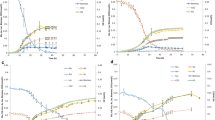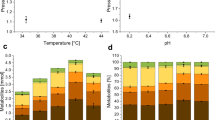Abstract
NMR analysis of 13C-labelling patterns showed that the Embden–Meyerhof (EM) pathway is the main route for glycolysis in the extreme thermophile Caldicellulosiruptor saccharolyticus. Glucose fermentation via the EM pathway to acetate results in a theoretical yield of 4 mol of hydrogen and 2 mol of acetate per mole of glucose. Previously, approximately 70% of the theoretical maximum hydrogen yield has been reached in batch fermentations. In this study, hydrogen and acetate yields have been determined at different dilution rates during continuous cultivation. The yields were dependent on the growth rate. The highest hydrogen yields of 82 to 90% of theoretical maximum (3.3 to 3.6 mol H2 per mol glucose) were obtained at low growth rates when a relatively larger part of the consumed glucose is used for maintenance. The hydrogen productivity showed the opposite effect. Both the specific and the volumetric hydrogen production rates were highest at the higher growth rates, reaching values of respectively 30 mmol g−1 h−1 and 20 mmol l−1 h−1. An industrial process for biohydrogen production will require a bioreactor design, which enables an optimal mix of high productivity and high yield.



Similar content being viewed by others
References
Bauchop T, Elsden SR (1960) The growth of micro-organisms in relation to their energy supply. J Gen Microbiol 23:457–469
Benemann J (1996) Hydrogen biotechnology: Progress and prospects. Nat Biotechnol 14:1101–1103
Claassen PAM, de Vrije T (2006) Non-thermal production of pure hydrogen from biomass: HYVOLUTION. Int J Hydrogen Energy 31:1416–1423
Claassen PAM, van Lier JB, Lopez Contreras AM, van Niel EWJ, Sijtsma L, Stams AJM, de Vries SS, Weusthuis RA (1999) Utilization of biomass for the supply of energy carriers. Appl Microbiol Biotechnol 52:741–755
Claassen PAM, Budde MAW, van der Wal FJ, Kádár Zs, van Noorden GE, de Vrije T (2002) Biological hydrogen production from biomass by thermophilic bacteria. In: Palz W, Spitzer J, Maniatis K, Kwant K, Helm P, Grassi A (eds) Biomass for energy, industry and climate protection. Proceedings of the Twelfth European Biomass Conference, Amsterdam, the Netherlands, ETA–Florence, Florence and WIP–Munich, Munich, pp 529–532
de Vrije T, Claassen PAM (2003) Dark hydrogen fermentations. In: Reith JH, Wijffels RH, Barten H (eds) Bio-methane & bio-hydrogen. Status and perspectives of biological methane and hydrogen production. Smiet Offset, The Hague, pp 103–123
Hagen WR (2006) IHEC-2005: Biohydrogen. Int J Hydrogen Energy 31:1413–1415
Hallenbeck PC (2005) Fundamentals of the fermentative production of hydrogen. Water Sci Technol 52:21–29
Kádár Zs, de Vrije T, van Noorden GE, Budde MAW, Szengyel Zs, Réczey K, Claassen PAM (2004) Yields from glucose, xylose, and paper sludge hydrolysate during hydrogen production by the extreme thermophile Caldicellulosiruptor saccharolyticus. Appl Biochem Biotechnol 114:497–508
Kengen SWM, Stams AJM, de Vos WM (1996) Sugar metabolism of hyperthermophiles. FEMS Microbiol Rev 18:119–137
Levin DB, Pitt L, Love M (2004) Biohydrogen production: prospects and limitations to practical applications. Int J Hydrogen Energy 29:173–185
Luedeking R, Piret EL (1959) A kinetic study of lactic acid fermentation. Batch process at controlled pH. J Biochem Microbiol Technol Eng 1:359–412
Nandi R, Sengupta S (1998) Microbial production of hydrogen: an overview. Crit Rev Microbiol 24:61–84
Nelson KE, Clayton RA, Gill SR, Gwinn ML, Dodson RJ, Haft DH, Hickey EK, Peterson JD, Nelson WC, Ketchum KA, McDonald L, Utterback TR, Malek JA, Linher KD, Garrett MM, Stewart AM, Cotton MD, Pratt MS, Phillips CA, Richardson D, Heidelberg J, Sutton GG, Fleischmann RD, Eisen JA, White O, Salzberg SL, Smith HO, Venter JC, Fraser CM (1999) Evidence for lateral gene transfer between Archaea and Bacteria from genome sequence of Thermotoga maritima. Nature 399:323–329
Pirt SJ (1965) The maintenance energy of bacteria in growing cultures. Proc R Soc Lond Ser B 163:224–231
Rainey FA, Donnison AM, Janssen PH, Saul D, Rodrigo A, Bergquist PL, Daniel RM, Stackebrandt E, Morgan HW (1994) Description of Caldicellulosiruptor saccharolyticus gen. Nov., sp. nov: An obligate anaerobic, extremely thermophilic, cellulolytic bacterium. FEMS Microbiol Lett 120:263–266
Ronimus RS, Morgan HW (2003) Distribution and phylogenies of enzymes of the Embden–Meyerhof–Parnas pathway form archaea and hyperthermophilic bacteria support a gluconeogenic origin of metabolism. Archaea 1:199–221
Schäfer T, Xavier KB, Santos H, Schönheit P (1994) Glucose fermentation to acetate and alanine in resting cell suspensions of Pyrococcus furiosus: proposal of a novel glycolytic pathway based on 13C labelling data and enzyme activities. FEMS Microbiol Lett 121:107–114
Schönheit P, Schäfer T (1995) Metabolism of hyperthermophiles. World J Microbiol Biotechnol 11:26–57
Schröder C, Selig M, Schönheit P (1994) Glucose fermentation to acetate, CO2 and H2 in the anaerobic hyperthermophilic eubacterium Thermotoga maritima: involvement of the Embden–Meyerhof pathway. Arch Microbiol 161:460–470
Selig M, Xavier KB, Santos H, Schönheit P (1997) Comparative analysis of Embden–Meyerhof and Entner–Doudoroff glycolytic pathways in hyperthermophilic archaea and the bacterium Thermotoga. Arch Microbiol 167:217–232
Van Niel EWJ, Budde MAW, de Haas GG, van der Wal FJ, Claassen PAM, Stams AJM (2002) Distinctive properties of high hydrogen producing extreme thermophiles, Caldicellulosiruptor saccharolyticus and Thermotoga elfii. Int J Hydrogen Energy 27:1391–1398
Van Niel EWJ, Claassen PAM, Stams AJM (2003) Substrate and product inhibition of hydrogen production by the extreme thermophile, Caldicellulosiruptor saccharolyticus. Biotechnol Bioeng 81:255–262
Verhees CH, Kengen SWM, Tuininga JE, Schut GJ, Adams MWW, de Vos WM, van der Oost J (2003) The unique features of glycolytic pathways in Archaea. Biochem J 375:231–246
Woodward J, Orr M, Cordray K, Greenbaum E (2000) Enzymatic production of biohydrogen. Nature 405:1014–1015
Acknowledgement
Jacinta van der Putten is acknowledged for thermogravimetric analyses of ash contents. Determinations of elemental compositions were done by the Analytical Department of Energy research Centre of the Netherlands (ECN). This study was financially supported by the Dutch Programme Economy, Ecology, Technology (EET), a joint initiative of the Ministries of Economic Affairs, Education, Culture and Sciences and of Housing, Spatial Planning and the Environment (EETK03028 BWPII), the Commission of the European Communities, Sixth Framework Programme, Priority 6, Sustainable Energy Systems (019825 HYVOLUTION) and the Dutch Ministry of Agriculture, Nature and Food Quality.
Author information
Authors and Affiliations
Corresponding author
Rights and permissions
About this article
Cite this article
de Vrije, T., Mars, A.E., Budde, M.A.W. et al. Glycolytic pathway and hydrogen yield studies of the extreme thermophile Caldicellulosiruptor saccharolyticus . Appl Microbiol Biotechnol 74, 1358–1367 (2007). https://doi.org/10.1007/s00253-006-0783-x
Received:
Revised:
Accepted:
Published:
Issue Date:
DOI: https://doi.org/10.1007/s00253-006-0783-x




